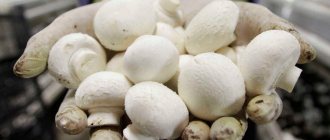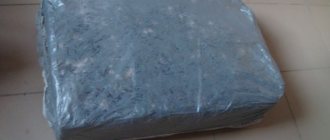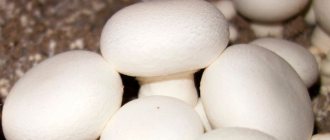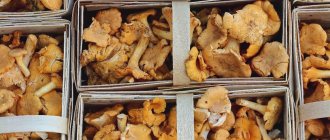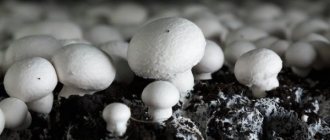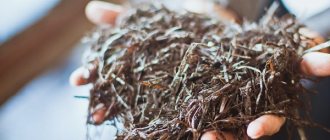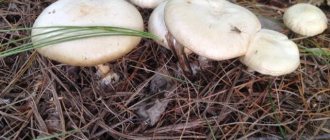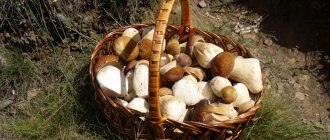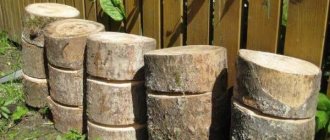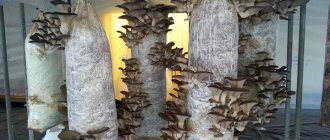This way, you can harvest the mushroom harvest that you need. At the same time, you won’t have to drive and spend a lot of time and gasoline. And growing champignons as a business is a great idea for making money (on average, these mushrooms cost 50 rubles per kilogram, but in some regions the price may vary significantly). Regardless of the goal you set for yourself, you need to know how to grow champignons at home. And this will be discussed in this article.
Where do champignons grow in nature?
Growing champignon mushrooms should start from the very basics. Champignon (lat. Agaricus) is a genus of lamellar mushrooms of the Champignon (Agaricaceae) family. These mushrooms can grow in almost any area where there is humus rich in organic matter. It could be a forest, a clearing, anthills, dead trees, they can be found even among tall grass. It is equally important to know what champignons look like so that you can find them in the forest.
The fruit bodies of champignons can be of different sizes: from 3 to 20 centimeters. The cap is dense, rounded, but becomes flatter with age. The color of the mushroom is usually white or brownish; sometimes you can find brown mushrooms. When exposed to air, the flesh of the mushroom acquires a yellowish, or less often reddish, tint. Champignons have a mushroom smell (similar to anise), so if it is absent, then you should be wary (in case you have picked a false champignon). A characteristic element of the mushroom is a ring that leaves a private covering on the stem.
Do I need permission to open?
This type of activity is the most problematic, since to open it you need to have the following permissions:
- certificate of phytosanitary institution;
- declaration of conformity to GOST;
- instructions for storage and transportation of products;
- document confirming the passage of radiological control.
( 8 ratings, average: 2.00 out of 5)
Loading…
Similar business ideas:
- The best business ideas for a village
- TOP 30 business ideas with minimal investment
- TOP 30 business ideas without investment
- Growing truffles as a business
Conditions for growing champignons at home
Are you interested in how to grow champignons in the country step by step and from scratch? Then you need to know the basic conditions for mushroom cultivation. If you correctly create the conditions listed below and install equipment for growing mushrooms, then you can collect champignons all year round. Some people leave this business as a hobby, and some build a business plan for growing champignons and put production on stream. But still, you first need to create the necessary conditions for the growth of champignon in an apartment, basement, garden plot and other places. So, you definitely need:
- choose the right place;
- disinfect the room;
- create the necessary microclimate;
- properly prepare and then use the substrate;
- lay the compost according to the rules;
- equipment for growing champignons;
- choose or grow mycelium yourself;
- proper care during the growth and development of the mycelium.
Separately, I would like to highlight the importance of oxygen and air renewal for mushrooms indoors. This is especially true for the basement and greenhouse. The fact is that during the growth process, champignons, like any other mushrooms, consume oxygen and release carbon dioxide. If there is no constant renewal of air (that is, high-quality ventilation), then the mushrooms will stop growing and then completely wither away. By observing all the above conditions, you will be able to enjoy your first harvest in just a few months. After all, champignons grow quickly, and they are not as fastidious as other mushrooms. Therefore, let's next look at how to grow champignons in the basement, since this room is used most often. But first things first.
Selection and preparation of premises
Growing mushrooms does not require any special knowledge or skills. The best place for such a business is the basement or cellar of a private house. Mushrooms are not heat-loving and do not require constant lighting. If there is no basement, it is permissible to carry out the procedure in a greenhouse in a country house or barn.
The room must have concrete walls, cemented floors and good ventilation. Mesh material used to cover the ventilation holes will help prevent pest attacks. The walls and ceiling must be limed.
How to grow champignons in the basement
The basement is an ideal place for growing champignons, if you equip it correctly and know how to grow champignons in the basement. Since mushrooms require high humidity, the room must first be disinfected (otherwise mold or other pathogenic microflora will quickly appear and destroy the mushrooms). There are several ways to disinfect a basement or any other room:
- whitewash (2-3 kg) with the addition of copper sulfate (100 g) and water (10 l);
- irrigation of the walls with bleach (350 g) diluted in water (10 l);
- irrigation of walls with 4% formaldehyde;
- use of sulfur bomb;
- chlorophos - used only if other methods do not work (too toxic).
Any disinfection method can be used, but the most commonly used is whitewashing of all surfaces. In any case, after disinfection, the room must be thoroughly ventilated. Since all of the above substances are toxic and can be dangerous to the human respiratory system. Do not forget to do high-quality ventilation first (the air should be fresh, but there should be no drafts). It is advisable to cover the pipes with a mesh with small cells to prevent insects from entering the mushroom farm.
To fully know how to grow champignons in the basement, you need to know a few more rules. So, you should install a thermometer and a hygrometer to monitor the humidity and temperature. If the humidity decreases, the soil needs to be irrigated with water. But if it’s hot in the summer and the temperature is high, then you should turn on the fans. To grow mushrooms in winter you will definitely need a heating system. It is advisable that the floor be earthen rather than concrete.
If you plan to take up this business globally and put the cultivation of champignons on stream, then you should divide the room into 2 parts. In one the champignons will be born (incubation, so to speak, thanks to the mycelium), in the second there will be boxes with the champignons themselves for forcing. The temperature of the room with the mycelium and “embryos” of mushrooms should be in the region of 23-25 degrees Celsius. But the more “mature” ones should be in a room with a temperature of 16-18 degrees Celsius.
What diseases and pests can cause harm?
Basic disinfection of the premises using smoke bombs, spraying and liming will help fight pests and diseases. But occasionally there are situations when mushrooms are exposed to various diseases and pests. The most common ones include:
| Name | Causes | Fighting methods |
| Fungus mite | A small yellow parasite that eats the stems of mushrooms. | Eliminate the problem by spraying mushrooms and compost with a 0.1% metaphos solution. |
| Mummies | A disease that occurs due to lack of light. The mushroom caps become dark gray and the flesh turns brown. | Remove the infected mycelium along with the substrate. |
| Mushroom midge | Fly larvae that end up in the compost along with manure. Over time, the mycelium becomes affected, which can lead to the cessation of fruiting and death. | The compost is treated with 0.5% chlorophos. |
| Rotting mushrooms | The development of the disease occurs with direct penetration of moisture into the already formed mycelium. This leads to immediate infection of other fungi. | Damaged myceliums are removed, those that remain are treated with a formaldehyde solution with a concentration of 0.2%. |
| Mold | Wet brown spots form on the surface of the mushrooms and increase in size. | Diseased mushrooms are removed, the substrate is sprinkled with superphosphate and table salt. |
Compost for growing champignons
Mushroom compost soil is an important part to ensure that mushrooms grow quickly on a large scale and are of high quality. Usually, when purchasing mycelium, it is already written on the package what kind of compost is required for this type of champignon. And if you compare several types of mycelium, it becomes clear that most require the same or very similar soil. Here are a few basic components for creating compost for growing mushrooms with your own hands:
- use horse manure, while the horses had to eat hay (not green grass);
- the moisture content of horse manure should be approximately 45% (+-5% error), and the volume will need at least 100 kg;
- dry wheat (or rye) straw - you need 100 kg;
- alabaster or otherwise gypsum – 6 kg.
This is the entire composition of the compost, which is suitable for almost all types of champignon mycelium. And if you don’t like gypsum, then you can replace it with 2-3 kg of urea or the same amount of nitrate. And one experienced mushroom picker, in response to the question of how champignons are grown on an industrial scale, said that he uses 100 kg of straw and horse manure, 3 kg of urea, 5 kg of chalk, 2 kg of superphosphate and 8 kg of gypsum. This ratio of compost components creates the ideal combination of all the necessary substances for the rapid growth of high-quality champignons.
But it is important not only to mix the right amount of ingredients, but also to do it correctly. There are special instructions for creating compost for growing champignons:
- Place all the straw in a wide container and fill it with hot water for one day.
- Lay a plastic film on the ground, on which we will lay layers (this is necessary to prevent insects and other animals from growing inside the compost).
- Lay layers of straw and horse manure in 5-6 layers; each layer must be slightly moistened with warm water (but there is no need to water it abundantly).
- After 3 days, mix the straw with horse manure, and add fertilizer at the same time: superphosphate and urea.
- The resulting mass will smell like ammonia - this is normal, you need to wait another day.
- Mix the straw-manure mass again, adding the remaining compost components.
- Wait another 1 day, then mix the future compost again.
- The future soil for the mycelium will be prepared within 20 days, during which it should be mixed 3-4 times (during this time the workpiece should not be exposed to precipitation or direct sunlight, that is, a good canopy will be needed).
- A signal that the compost is ready will be the absence of an ammonia smell.
I would like to note that the compost should not be moistened too much. Firstly, high humidity slows down the growth of mushrooms. Secondly, a large amount of water washes away salts and nutrients, which is why the mushrooms will be of poor quality or may even die. After preparing the compost, you can proceed to planting the mycelium.
Champignon mycelium - planting
Many people are often interested in how to make champignon mycelium at home. Unfortunately, this task is extremely difficult to complete and takes a lot of time. But the answer to the question of how to grow champignon mycelium at home is much simpler. Since in this case, a purchased mycelium that is ready for planting is used. The mature compost must be transferred to boxes or another place where mushrooms will grow in the future. Then you need to plant the already purchased champignon mycelium:
- For 1 square meter of compost, 500 g of mycelium or 400 g of mushroom spores are used.
- Make holes at a distance of 20 centimeters from each other, the depth of which will be 4-6 centimeters, plant the mycelium in them (if you use spores, then you just need to scatter them over the surface).
- Create high humidity in the basement (about 80-90%), periodically the substrate must be irrigated with water from a spray bottle and covered with a damp cloth, the temperature in the basement should be about 24 degrees Celsius.
- After a few days, a mushroom web will appear, and on the 10th-12th day the compost should be sprinkled with soil mixture (read the instructions on the package).
- On days 15-17, the boxes with mycelium must be dragged to a cooler room (16-20 degrees Celsius) or the temperature in this place must be artificially lowered to the required numbers.
The harvest from one mycelium can be harvested 5-8 times, but the largest number of mushrooms appears in the first three waves (the first harvest appears after 2-3 months, some varieties begin to bear fruit only closer to the 4th month of growth). After each harvest, it is necessary to sprinkle with the soil mixture that was used in step 4. By the way, if you don’t want to buy this mixture in a store, you can make it yourself. You only need to mix 1 share of limestone, 4 parts of clean soil, 5 parts of peat.
How to grow champignons at the dacha in open ground
In fact, to grow champignons in a garden plot or vegetable garden, you must adhere to the same rules as described above. If it is not possible to create suitable compost, then soil for mushrooms can be brought from the forest where champignons grow. It is better to plant the mycelium of mushrooms in an area with shade, so that there are no direct rays. On hot and sunny days, you need to cover the mushrooms with film and water them periodically. Humidity and temperature should be exactly the same as in the basement. But if mushrooms can be grown in the basement all year round, then in open ground it is better to plant mycelium in summer or autumn, preferably during a period when there is little rainfall.
Equipment
When compiling a list of equipment used for growing champignons, it should be taken into account that production processes are not limited to mycelium incubation and fruiting.
Therefore, this list will have to include not only heating and ventilation devices, but also refrigeration chambers for temporary storage of crops, hand tools, and even transport for delivering products and raw materials. To equip a farm located in a basement with an area of 80 m² and consisting of two chambers of 35 m² each, the following expenses must be included in the business plan for growing champignons:
Equipment list
| Name | price, rub. | Quantity, pcs. | Amount, rub. |
| Climatic equipment | |||
| Fan, 700 m³/h | 3700 | 4 | 14800 |
| Fine filter | 1200 | 2 | 2400 |
| Humidifier, 35 m² | 2500 | 2 | 5000 |
| Water heating oven | 16000 | 1 | 16000 |
| Water heat exchanger radiator | 4500 | 2 | 9000 |
| Thermohygrometer | 900 | 1 | 900 |
| Air cooler | 22000 | 2 | 44000 |
| Ventilation and heating pipelines | – | – | 8000 |
| Electrical equipment | |||
| Lamp | 400 | 8 | 3200 |
| Wires and switches | – | – | 5000 |
| quartz lamp | 3500 | 1 | 3500 |
| Fly lamp | 1000 | 2 | 2000 |
| Irrigation equipment | |||
| Irrigation barrels 200 l | 350 | 2 | 700 |
| Hoses and sprayers | – | – | 3000 |
| Water pump | 2000 | 1 | 2000 |
| Auxiliary equipment | |||
| cooling chamber | 13000 | 1 | 13000 |
| Galvanized rack 2x1x0.8 m | 5000 | 50 | 250000 |
| Small scales | 800 | 1 | 800 |
| Garden wheelbarrow | 1200 | 2 | 2400 |
| Hand tool | – | – | 2000 |
| indicator paper | 200 | 1 | 200 |
| Car with thermal booth | 190000 | 1 | 190000 |
| Total: | 577900 | ||
An entrepreneur who wants to prepare a substrate for growing champignons on his own will have to additionally purchase two fans for ventilating the pasteurization and fermentation chambers, a steam generator, and a straw cutter for grinding compost components.
When to harvest champignons
Now you know how to grow champignons at home. All that remains is to consider what time to harvest the mushroom harvest. Experienced mushroom pickers recommend picking champignons at the moment when the mushroom cap is covered with film from below and the brown plates are not yet visible. It is not recommended to cut the champignons with a knife. The fact is that pathogenic microflora can enter the mycelium through the cut site, and the mycelium will die (okay, if this is the 6-8th wave, but what if this is only the first wave of the harvest? It will be a shame). Therefore, it is better to carefully twist the mushrooms, trying not to damage the mycelium. Don’t forget to sprinkle the substrate with earth mixture immediately after harvesting so that the next wave is no smaller.
Inoculation
Suppliers involved in the cultivation of champignon mycelium must be found in advance.
If there are doubts about the quality of the product, it is advisable to carry out several test sowings to ensure the viability of the seed: haste at this stage can lead to damage to the entire batch of substrate and inevitable associated losses. Inoculation is carried out after the compost has cooled to a temperature of 23–25°C. For a standard bed 20 cm high, the consumption rate of grain mycelium does not exceed 0.5 kg/m². Sowing is most often carried out using the nesting method: lumps of mycelium slightly smaller than a walnut are placed in holes 7–8 cm deep, dug in the compost in a checkerboard pattern with steps of 18–20 cm. Then, to maintain soil moisture at the proper level, the beds are covered with film or damp newspapers .
If all components are selected correctly and the temperature is maintained at 23–25°C, the substrate will be completely overgrown with mycelium in two weeks. At this stage, ventilation is turned on only to cool the air in the incubation chamber or to reduce humidity, since a high concentration of carbon dioxide contributes to the accelerated development of the mycelium.
The most productive varieties of champignons
To profitably grow champignons for sale, you need to choose the most productive varieties. Silvan130 (fast growth, high yield), Somicel512 and Somicel608 (the mycelium produces a harvest for a long time - about 10-15 waves - but requires careful care), Hauser A15 (high yield, unpretentious, wide cap) are ideal for cellars and summer cottages. And if you plan to grow champignons at home or in the basement all year round, then you can consider options such as Horst V1 or V3. But it is important to note that the above varieties are some of the most expensive mushrooms. No wonder they are the best. But if you turn this into a business, the expenses will quickly pay off.
Where to sell finished products?
Business is seasonal. The demand for champignons increases in winter and spring. In summer and autumn the rate drops. The reason is the appearance of forest mushrooms.
You can sell mushrooms in grocery stores and chain stores. They are reluctant to cooperate and demand payment for shelf space. An alternative is to sell mushrooms to processors, resellers, cafes and restaurants. You can also sell mushrooms at your point of sale - if it is equipped with a refrigerator.
To summarize
So, growing champignons is a profitable business that you can do for your soul. Do not forget the basic rules: special soil, special conditions, temperature and humidity are required, and with the first harvest, the amount of watering should be reduced to prevent rotting of the roots. If you create the right conditions, mushrooms can be grown all year round. Usually mycelium produces 6-8 waves of harvest, but some types of champignons can produce up to 15 waves. If you still have any questions, ask them in the comments below the article. We will definitely respond as soon as possible. Good luck in your endeavors!
Investments
Video on the topic
Organizing the operation of a mushroom farm involves costs for purchasing equipment, repairing the basement, registering an enterprise and developing an information website for buyers.
Investments
| Name | price, rub. | Qty | Amount, rub. |
| Pouring the floor with concrete | 3530 | 8 m³ | 28240 |
| Installation of partitions | 800 | 20 m | 16000 |
| SPD registration | – | – | 2000 |
| Radiological examination protocol | 4500 | 1 PC. | 4500 |
| Site development | 10000 | 1 PC. | 10000 |
| Equipment | – | – | 577900 |
| Installation of equipment | – | – | 10000 |
| Total: | 648640 | ||
Also, in the first cycle of growing champignons, it is necessary to purchase and bring compost, mycelium, firewood or coal for the stove, and chemicals for disinfecting the room. These costs will be repeated in subsequent cycles.
Cycle costs
| Name | price, rub. | Qty | Amount, rub. |
| Compost | 8000 | 16 t | 128000 |
| Grain mycelium, strain A15 | 180 | 80 kg | 14400 |
| Cover soil | 1500 | 6.4 m³ | 9600 |
| Delivery of compost and soil | – | – | 7500 |
| Lime | 65 | 4 kg | 260 |
| fuels and lubricants | 27 | 100 l | 2700 |
| Firewood for the stove | 800 | 1.5 m³ | 1200 |
| Sulfur checkers | 120 | 10 pieces. | 1200 |
| Communal payments | 4 | 2880 kW | 11520 |
| Certificate of conformity | 3500 | 1 PC. | 3500 |
| Insurance payments for peasant farms or individual entrepreneurs | 2300 | 2 months | 4600 |
| Total: | 184480 | ||
Reproduction
After the mushroom crop has been harvested, the area can be rejuvenated by adding new planting material, or it can be converted to gardening and planted vegetables.
Did you know? Translated from French, “champignon” means “mushroom”.
But in some regions it is called pecheritsa, which is interpreted as a white (in color) mushroom, field champignon.
You can propagate mycelium on wet shredded cardboard in a container with holes in the bottom. To do this, place a damp cardboard mixture around each mushroom root. The container should stand in a damp and dark place for 1-2 months until white spider-like growth of new mycelium appears on the surface. In the future, the resulting planting material must be planted in a new place chosen at the dacha.
Growing mushrooms today is much easier than before, when they were produced by giant farms using laboratory growing methods, expensive equipment and high levels of precision. Now, thanks to more affordable and effective methods, the process of growing champignons can be done at your summer cottage and provide yourself with a tasty and nutritious product without long trips to the forest and possible risks during collection.
Phased development
In order to start growing champignons, it is enough to rent or allocate your own premises, the area of which is at least 350 square meters. This could be a warehouse, a basement, or even a small one-story house. Do you remember that we discussed buying compost? So, in this regard, you can get by with a minimum staff of 4-5 people, not counting the head of the company. Specialists whose help you can’t do without are a technologist, an accountant, a harvester and someone who will sell the product to the catering market.
In order for a company to operate officially and legally, it is enough to register as an individual entrepreneur who is required to pay tax according to the simplified taxation system.
Landing
You can plant mycelium from the beginning of spring to the end of summer, trying to shade the beds during high summer temperatures.
Important! Do not use chemical fertilizers as mushrooms will not grow in such conditions.
The sequence of actions during landing can be represented as follows:
- Mushroom beds look different from the usual plots for vegetables - they are not a hill, but depressions (30 cm), lined with a drainage layer, on top of which the substrate is placed and compacted.
- The mycelium should be planted evenly, distributing it over the entire surface of the compost, and then sprinkled with water. Try to make an even layer on the substrate so that the mushrooms grow in all parts of the soil.
- The top of the bed is sprinkled with the covering mixture from the kit or peat mixed with chalk in a ratio of 4:1, with a layer of 2–3 cm. Instead of peat, you can use garden soil or crushed waste paper, but be sure to add chalk or dolomite chips to ensure the alkaline characteristics of the composition.
- The period of active growth takes about 2–3 weeks. During this time, the substrate will be colonized with white mycelium threads to a depth of 1 cm.
To activate growth and fruiting, faster ripening of fruiting bodies and improve their quality, it is recommended to treat the substrate with mycelium with “Epin” (0.005 ml/m²) before planting and at the beginning of each wave of fruiting. This ensures earlier fruiting (4–6 days) and increases yield by 20%.
Possible risks
Like any business, growing champignons has its pitfalls. They must be taken into account before taking on this work.
There are such risks that can affect both the production process and the result:
- Production technology should not be violated , because the slightest deviation from the norm can lead to a decrease in yield.
- Mushrooms are very sensitive to changes in the external environment , and the slightest violation of temperature conditions, humidity, or insufficient ventilation can destroy the spores and destroy the crop or part of it.
- To make a good profit , it is necessary to ensure stability of work and take care of sales channels in advance. The entire technological process must be clearly debugged from start to finish.
- Watering should be done only by sprinkling , otherwise the mushrooms may not sprout.
- The price level for finished compost is rising significantly , which can significantly increase production costs.
- It is better to buy mycelium ready-made and from trusted suppliers , since it is almost impossible to grow it at home. Most often, self-cultivation ends in a waste of money.
- Since the demand for mushrooms is quite high , more and more enterprises engaged in their cultivation are appearing, which greatly increases the level of competition. To be successful in this business, you need to constantly improve the quality of the product and take advantage of other competitive advantages.
- Business can be affected by natural disasters , fires, emergencies, from which you can protect yourself by taking out insurance.
How quickly Polish mushrooms grow. Useful qualities of Polish mushrooms
They are primarily due to the theanine they contain. Polish mushroom provides:
- Reduced blood pressure.
- Promoting calm and relaxation.
- Increasing immunity to cancer.
- Eliminates the harmful effects of caffeine.
- Helps reduce weight.
- Neuroprotective effect.
Chinese biochemists have recently developed and begun to apply methods for obtaining theanine by semi-submersible cultivation of the mycelium of this fungus and its subsequent fermentation.
Indole compounds were found in these moss mushrooms - serotonin, tryptamine, tryptophan, kynurenic acid and kynurene sulfate. Polysaccharides that have an antitumor effect were found in the alcoholic extract of fresh mushrooms (testing on mice demonstrated 60% activity against sarcoma and 70% activity against Ehrlich carcinoma). Dried mushroom extract in methanol demonstrated high antioxidant properties. At a concentration of 100 mg/l, the inhibition of linolenic acid peroxidation was 99.2%, which is higher than the standard values for solutions of alpha-tocopherol (77%), BHA (77%) and BHT (97%) having a concentration of 400 mg/l. Methanol extract neutralizes active oxygen better than other mushrooms that have antioxidant properties.
The ability of the Polish mushroom to overactively accumulate heavy metals contained in the soil (cobalt, mercury, lead, cadmium) was also noticed. On the affected Chernobyl lands, these fungi accumulated a lot of the radioactive isotope cesium-137. Using this ability, a technique is being developed for extracting radioactive and heavy elements from the soil for the purpose of its gradual purification.
Do you like picking Polish mushrooms? What's the biggest harvest you've ever harvested? Tell us about it in the comments.
Among all the mushrooms known to science, there are special ones that are most popular and liked by mushroom pickers. The Polish mushroom (see photo) is a favorite of mushroom pickers; many people like it very much for its exceptional taste, aroma and abundance.
Polish mushrooms are called chestnut mushroom, panski mushroom or brown mushroom. In terms of richness and quality of taste and aroma, the Polish mushroom can be equated to white mushroom. By what signs can you recognize a Polish mushroom, where and when does it grow, and also why it is useful - read about all this and more below.
Applications
ANNEX 1
Main financial indicators of the project in a five-year perspective
29.04.2016
All materials by tag: growing mushrooms
Calculator for calculating the profitability of this business
Net profit (monthly):
Payback period:
Profitability:
More detailed calculations can be made in our free application
Save the article to study the material carefully
Remember article
You can save this page using:
Profitability, how much income you can get
The profitability of this business ranges from 25% to 40%. But initially the income will be minimal. The average cost of 1 kilogram of champignons is 200 rubles. In the first 2 months, production will be unprofitable, since this period will be required to grow the crop.
With a stable increase in mushroom emergence over three years, the yield indicator should increase by 2 tons. Average monthly revenue is about 83 thousand rubles. Taking into account monthly expenses, net profit varies from 11 to 40 thousand rubles, depending on whether additional workers are involved in production or not.
In the second year, net profit will increase to an amount from 30 to 70 thousand rubles. In the third year - from 60 to 100 thousand rubles.
Where to begin?
Initially, it is necessary to develop a business plan for growing and selling champignons. It includes the following steps:
- approximate calculations of the amount of starting capital;
- business registration;
- arrangement of premises for growing mushrooms;
- purchase of necessary equipment and materials;
- selection of the most productive types of champignons, and study of the technology of their cultivation;
- personnel selection;
- searching for ways to sell products.
It is first necessary to study the potential sales market and calculate the approximate volume of champignons that can be sold. You should also foresee possible risks and develop ways to solve them.
It is not recommended to immediately give up your main source of income and switch to growing mushrooms. Champignons are susceptible to diseases and attacks by parasites, so for inexperienced people at the initial stage this type of business is accompanied by losses. For a stable income, you will need to maintain a specific volume of production, which is quite difficult to do.
Without knowing the technology for growing champignons, it is difficult to organize conditions suitable for mushroom growth. By ignoring diseases and parasites, you can lose your entire harvest. Therefore, before you start growing champignons, you need to carefully study the theoretical information.
